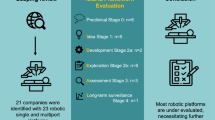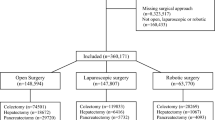Abstract
After decades of reluctance to change surgical approaches, new technologies have created new perspectives for surgery. Initially, the laparoscopic approach was considered to be only one useful for relatively simple procedures as the design of the instruments and the limited access hampered free movements to perform complicated surgery. Robotic systems overcame this problem and boosted the use of minimally invasive techniques also for radical gynaecological surgery. Robot-assisted laparoscopy can now routinely be used for the surgical treatment of early or downstaged cervical carcinoma, endometrial carcinoma and staging of early ovarian carcinoma. Robot-assisted laparoscopy has proven to be feasible, although the benefits for the patient are less clear than those for the surgeon. The main advantage of robot-assisted laparoscopy over conventional laparoscopy is probably not that it is safer or better, but that it allows more types of radical surgery to be performed and that it prevents the surgeon from developing complaints and muscular conditions that interfere with the ability to perform surgery. New applications have emerged with the introduction of new devices to be used in conjunction with the robotic system as well as with totally new robotic systems. Training in these new tools should be more systematic and structured to allow their safe introduction and use.

Similar content being viewed by others
References
Papers of particular interest, published recently, have been highlighted as: • Of importance •• Of major importance
Wertheim E. The extended abdominal operation for carcinoma uteri. Am J Obstet Dis Women Child. 1912;66:169–232.
Reich H, DeCaprio J, et al. Laparoscopic hysterectomy. J Gynecol Surg. 1989;5:213–6.
Dargent D. A new future for Schauta’s operation through pre-surgical retroperitoneal pelviscopy. Eur J Gynaecol Oncol. 1987;8:292–6.
Nezhat CR, Burrell MO, Nezhat FR, et al. Laparoscopic radical hysterectomy with paraaortic and pelvic node dissection. Am J Obstet Gynecol. 1992;166:864–5.
Sert BM, Abeler VM. Robotic-assisted laparoscopic radical hysterectomy (Piver type III) with pelvic node dissection–case report. Eur J Gynaecol Oncol. 2006;27:531–3.
Wexner SD, Bergamaschi R, Lacy A, et al. The current status of robotic pelvic surgery: results of a multinational interdisciplinary consensus conference. Surg Endosc. 2009;23:438–43.
Sarlos D, Kots LV, Stevanovic N, et al. Robotic hysterectomy versus conventional laparoscopic hysterectomy: costs and preliminary results of a randomized controlled trial. Arch Gynecol Obstet. 2010;282(Suppl):11–2.
Paraiso MF, Jelovsek JE, Frick A, et al. Laparoscopic compared with robotic sacrocolpopexy for vaginal prolapse: a randomized controlled trial. Obstet Gynecol. 2011;118:1005–13.
Baik SH, Ko YT, Kang CM, et al. Robotic tumor-specific mesorectal excision of rectal cancer: short-term outcome of a pilot randomized trial. Surg Endosc. 2008;22:1601–8.
Liu H, Lu D, Wang L, Shi G, Song H, Clarke J. Robotic surgery for benign gynaecological disease. Cochrane Database Syst Rev. 2012, Issue 2. Art. No.: CD008978. doi:10.1002/14651858.CD008978.pub2.
Lu D, Liu Z, Shi G, Liu D, Zhou X. Robotic assisted surgery for gynaecological cancer. Cochrane Database Syst Rev. 2012, Issue 1. Art. No.: CD008640. doi:10.1002/14651858.CD008640.pub2.
Obermair A, Gebski V, Frumovitz M, Soliman PT, Schmeler KM, Levenback C, et al. A phase III randomized clinical trial comparing laparoscopic or robotic radical hysterectomy with abdominal radical hysterectomy in patients with early stage cervical cancer. J Minim Invasive Gynecol. 2008;15:584–8.
• Herron DM, Marohm M. The SAGES MIRA Robotic Surgery Consensus Group. A consensus document on robotic surgery. Surg Endosc. 2008;22:313–25. This article is an example of recommendations and rules for the safe introduction of robotic surgery.
Inspectie voor de Gezondheidszorg. Ministerie van Volksgezondheid, Welzijn en Sport. Onvoldoende zorgvuldigheid bij introductie van operatierobots. Den Haag: 2010.
Seamon LG, Fowler JM, Richardson DL, et al. A detailed analysis of the learning curve: robotic hysterectomy and pelvic-aortic lymphadenectomy for endometrial cancer. Gynecol Oncol. 2009;114:162–7.
•• Schreuder HW, Wolswijk R, Zweemer RP, et al. Training and learning robotic surgery, time for a more structured approach: a systematic review. BJOG. 2012;119:137–49. This article highlights the importance of training in robot-assisted laparoscopy and gives an overview of requirements and current possibilities for adequate training.
Boggess JF, Gehrig PA, Cantrell L, et al. A case–control study of robot-assisted type III radical hysterectomy with pelvic lymph node dissection compared with open radical hysterectomy. Am J Obstet Gynecol. 2008;199:357.e1–7.
Kruijdenberg CB, van den Einden LC, Hendriks JC, et al. Robot-assisted versus total laparoscopic radical hysterectomy in early cervical cancer, a review. Gynecol Oncol. 2011;120:334–9.
Persson J, Kannisto P, Bossmar T. Robot-assisted abdominal laparoscopic radical trachelectomy. Gynecol Oncol. 2008;111:564–7.
Burnett AF, Stone PJ, Duckworth LA, et al. Robotic radical trachelectomy for preservation of fertility in early cervical cancer: case series and description of technique. J Minim Invasive Gynecol. 2009;16:569–72.
Lambaudie E, Narducci F, Bannier M, et al. Role of robot-assisted laparoscopy in adjuvant surgery for locally advanced cervical cancer. Eur J Surg Oncol. 2010;36:409–13.
Chan WS, Kong KK, Nikam YA, et al. Vaginal vault dehiscence after laparoscopic hysterectomy over a nine-year period at Sydney West Advanced Pelvic Surgery Unit - our experiences and current understanding of vaginal vault dehiscence. Aust N Z J Obstet Gynaecol. 2012;52:121–7.
Persson J, Reynisson P, Borgfeldt C, et al. Robot assisted laparoscopic radical hysterectomy and pelvic lymphadenectomy with short and long term morbidity data. Gynecol Oncol. 2009;113:185–90.
Uccella S, Ghezzi F, Mariani A, et al. Vaginal cuff closure after minimally invasive hysterectomy: our experience and systematic review of the literature. Am J Obstet Gynecol. 2011;205:119.e1–12.
Hwang JH, Lee JK, Lee NW, et al. Vaginal cuff closure: a comparison between the vaginal route and laparoscopic suture in patients undergoing total laparoscopic hysterectomy. Gynecol Obstet Invest. 2011;71:163–9.
ElSahwi KS, Hooper C, De Leon MC, et al. Comparison between 155 cases of robotic vs. 150 cases of open surgical staging for endometrial cancer. Gynecol Oncol. 2012;124:260–4.
Mourits MJ, Bijen CB, Arts HJ, et al. Safety of laparoscopy versus laparotomy in early-stage endometrial cancer: a randomised trial. Lancet Oncol. 2010;11:763–71.
Obermair A, Janda M, Baker J, Kondalsamy-Chennakesavan S, et al. Improved surgical safety after laparoscopic compared to open surgery for apparent early stage endometrial cancer: results from a randomised controlled trial. Eur J Cancer. 2012;48:1147–53.
Barnett JC, Judd JP, Wu JM, et al. Cost comparison among robotic, laparoscopic, and open hysterectomy for endometrial cancer. Obstet Gynecol. 2010;116:685–93.
Holloway RW, Brudie LA, Rakowski JA, et al. Robotic-assisted resection of liver and diaphragm recurrent ovarian carcinoma: description of technique. Gynecol Oncol. 2011;120:419–22.
Magrina JF, Zanagnolo V, Noble BN, et al. Robotic approach for ovarian cancer: perioperative and survival results and comparison with laparoscopy and laparotomy. Gynecol Oncol. 2011;121:100–5.
Farghaly SA. Robotic-assisted laparoscopic anterior pelvic exenteration in patients with advanced ovarian cancer: Farghaly's technique. Eur J Gynaecol Oncol. 2010;31(4):361–3.
Reynolds RK, Burke WM, Advincula AP. Preliminary experience with robot-assisted laparoscopic staging of gynecologic malignancies. JSLS. 2005;9:149–58.
Ordemann J, Jacobi CA, Schwenk W, et al. Cellular and humoral inflammatory response after laparoscopic and conventional colorectal resections. Surg Endosc. 2001;15:600–8.
Zhang N, Liu H, Zhang Z, et al. The difference of the impacts of surgical approaches on cellular immunity in patients with uterine malignancies: a comparative study of laparoscopy and laparotomy surgery. Gynecol Obstet Invest. 2011;71:177–82.
Sylla P, Kirman I, Whelan RL. Immunological advantages of advanced laparoscopy. Surg Clin North Am. 2005;85(1):1–18. vii.
Sert B. Robotic port-site and pelvic recurrences after robot-assisted laparoscopic radical hysterectomy for a stage IB1 adenocarcinoma of the cervix with negative lymph nodes. Int J Med Robot. 2010;6:132–5.
van de Lande J, von Mensdorff-Pouilly S, Lettinga RG, et al. Open versus laparoscopic pelvic lymph node dissection in early stage cervical cancer: no difference in surgical or disease outcome. Int J Gynecol Cancer. 2012;22:107–14.
Schreuder HW, Verheijen RH. Robotic surgery. BJOG. 2009;116:198–213.
Zorn KC, Gautam G, Shalhav AL. Training, credentialing, proctoring and medicolegal risks of robotic urological surgery: recommendations of the Society of Urologic Robotic Surgeons. J Urol. 2009;182:1126–32.
van Dam GM, Themelis G, Crane LM, et al. Intraoperative tumor-specific fluorescence imaging in ovarian cancer by folate receptor-alpha targeting: first in-human results. Nat Med. 2011;17:1315–9.
Crane LM, Themelis G, Pleijhuis RG, et al. Intraoperative multispectral fluorescence imaging for the detection of the sentinel lymph node in cervical cancer: a novel concept. Mol Imaging Biol. 2011;13(5):1043–9.
Disclosure
No potential conflicts of interest relevant to this article were reported.
Author information
Authors and Affiliations
Corresponding author
Rights and permissions
About this article
Cite this article
Verheijen, R., Zweemer, R. Robotic Surgery for Gynaecologic Cancer: An Overview. Curr Oncol Rep 14, 544–549 (2012). https://doi.org/10.1007/s11912-012-0270-8
Published:
Issue Date:
DOI: https://doi.org/10.1007/s11912-012-0270-8




